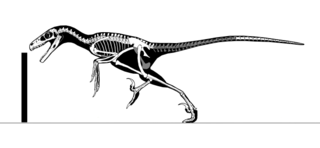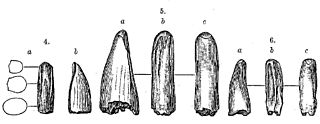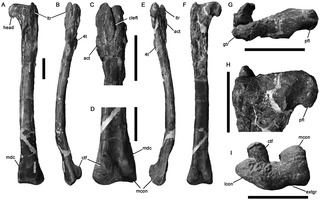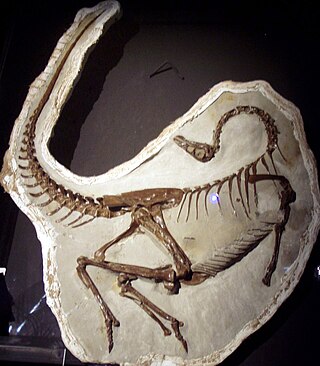This list of pathological conditions reported in Mesozoic dinosaurs enumerates the various types of injury, disease, deformity or parasite infection identified among Mesozoic dinosaur fossils.
| Pathology | Description | Taxa | Paleobiological significance | Images |
|---|---|---|---|---|
Allosaurus and Eubrontes (ichnotaxon) | ||||
Asymmetrically sized body parts. [6] | ||||
Fractured bones [1] [2] [5] [8] [11] [13] [14] [16] [17] [18] [19] [20] [21] | ||||
Supernumerary tooth crowns [10] | ||||
Twisted body parts [12] | ||||

Allosaurus is an extinct genus of large carnosaurian theropod dinosaur that lived 155 to 145 million years ago during the Late Jurassic period. The name "Allosaurus" means "different lizard", alluding to its unique concave vertebrae. It is derived from the Greek words ἄλλος and σαῦρος. The first fossil remains that could definitively be ascribed to this genus were described in 1877 by famed paleontologist Othniel Charles Marsh. As one of the first well-known theropod dinosaurs, it has long attracted attention outside of paleontological circles.

Saurornitholestes is a genus of carnivorous dromaeosaurid theropod dinosaur from the late Cretaceous of Canada (Alberta) and the United States.

An exostosis, also known as a bone spur, is the formation of new bone on the surface of a bone. Exostoses can cause chronic pain ranging from mild to debilitatingly severe, depending on the shape, size, and location of the lesion. It is most commonly found in places like the ribs, where small bone growths form, but sometimes larger growths can grow on places like the ankles, knees, shoulders, elbows and hips. Very rarely are they on the skull.

Aublysodon is a genus of carnivorous dinosaurs known only from the Judith River Formation in Montana, which has been dated to the late Campanian age of the late Cretaceous period. The only currently recognized species, Aublysodon mirandus, was named by paleontologist Joseph Leidy in 1868. It is sometimes considered dubious now, because the type specimen consists only of an isolated premaxillary (front) tooth. Although this specimen is now lost, similar teeth have been found in many US states, western Canada, and Asia. These teeth almost certainly belong to juvenile tyrannosaurine tyrannosaurids, but most have not been identified to species level. However, it is likely that the type tooth belongs to one of the species in the genus Daspletosaurus, which was present in contemporary formations, and which matches specific details of the original tooth. The synapomorphies alleged to distinguish the Aublysodontinae, especially lack of serrations on premaxillary teeth could have been caused by tooth wear in life, postmortem abrasion, or digestion. Most other "aublysodontine"-type teeth may be from ontogenetic stages or sexual morphs of other tyrannosaurids.

Sinraptor is a genus of metriacanthosaurid theropod dinosaur from the Late Jurassic. The name Sinraptor comes from the Latin prefix "Sino", meaning Chinese, and "raptor" meaning robber. The specific name dongi honours Dong Zhiming. Despite its name, Sinraptor is not related to dromaeosaurids like Velociraptor. Instead, it was a carnosaur distantly related to Allosaurus. Sinraptor and its close relatives were among the earliest members of the Jurassic carnosaurian radiation. Sinraptor still remains the best-known member of the family Metriacanthosauridae, with some older sources even using the name "Sinraptoridae" for the family.

Altispinax is a genus of large predatory theropod dinosaur from the Early Cretaceous period of what is now the Wadhurst Clay Formation of East Sussex, England.

Timimus is a genus of small coelurosaurian theropod dinosaur from the Early Cretaceous of Australia. It was originally identified as an ornithomimosaur, but now it is thought to be a different kind of theropod, possibly a tyrannosauroid.

Ornithomimidae is a family of theropod dinosaurs which bore a superficial resemblance to modern ostriches. Ornithomimids were fast, omnivorous or herbivorous dinosaurs known mainly from the Late Cretaceous Period of Laurasia, though they have also been reported from the Lower Cretaceous Wonthaggi Formation of Australia.

Elmisaurus is an extinct genus of caenagnathid dinosaur from the Late Cretaceous Nemegt Formation of Mongolia. It was a theropod belonging to the Oviraptorosauria.

Kelmayisaurus is an extinct genus of carcharodontosaurid theropod dinosaur from the Early Cretaceous. It was roughly 10–12 meters long and its name refers to the petroleum-producing city of Karamay in the Xinjiang province of western China near where it was found.

Marshosaurus is a genus of medium-sized carnivorous theropod dinosaur, belonging to the Megalosauroidea, from the Late Jurassic Morrison Formation of Utah and possibly Colorado.

Gastralia are dermal bones found in the ventral body wall of modern crocodilians and tuatara, and many prehistoric tetrapods. They are found between the sternum and pelvis, and do not articulate with the vertebrae. In these reptiles, gastralia provide support for the abdomen and attachment sites for abdominal muscles.
The Minhe Formation is a geological formation in northwestern China, whose strata date back to the Late Cretaceous period.
Sauroidichnites is an ichnotaxon of saurian reptiles. The name was originally used by Edward Hitchcock as a higher group name rather than a specific ichnogenus, and thus the name does not have priority over specific ichnogenus names even if they were first identified as Sauroidichnites.
Dinosaur diets and feeding behavior varied widely throughout the clade, including carnivorous, herbivorous, and omnivorous forms.
Theropod paleopathology is the study of injury and disease in theropod dinosaurs. In 2001, Ralph E. Molnar published a survey of pathologies in theropod dinosaur bone that uncovered pathological features in 21 genera from 10 theropod families. Pathologies have been seen on most theropod body parts, with the most common sites of preserved injury and disease being the ribs and tail vertebrae. The least common sites of preserved pathology are the weight-bearing bones like the tibia, femur and sacrum. Most pathologies preserved in theropod fossils are the remains of injuries, but infections and congenital deformities have also been documented. Pathologies are less frequently documented in small theropods, although this may simply be because the larger bones of correspondingly larger animals would be more likely to fossilize in the first place.

Egg paleopathology is the study of evidence for illness, injury, and deformity in fossilized eggs. A variety of pathological conditions afflicting eggs have been documented in the fossil record. Examples include eggshell of abnormal thickness and fossil eggs with multiple layers of eggshell. The identification of egg paleopathologies is complicated by the fact that even healthy eggs can be modified during or after fossilization. Paleontologists can use techniques like cathodoluminescence or thin sectioning to identify true paleopathologies in fossil eggs. Despite the diversity of paleopathologies known from fossil eggs, the vast majority of conditions known to afflict modern eggs have not yet been seen among fossils.

This timeline of tyrannosaur research is a chronological listing of events in the history of paleontology focused on the tyrannosaurs, a group of predatory theropod dinosaurs that began as small, long-armed bird-like creatures with elaborate cranial ornamentation but achieved apex predator status during the Late Cretaceous as their arms shrank and body size expanded. Although formally trained scientists did not begin to study tyrannosaur fossils until the mid-19th century, these remains may have been discovered by Native Americans and interpreted through a mythological lens. The Montana Crow tradition about thunder birds with two claws on their feet may have been inspired by isolated tyrannosaurid forelimbs found locally. Other legends possibly inspired by tyrannosaur remains include Cheyenne stories about a mythical creature called the Ahke, and Delaware stories about smoking the bones of ancient monsters to have wishes granted.

Latenivenatrix, meaning "hiding huntress", is a genus of large troodontid known from a single species, L. mcmasterae. Along with the contemporary Stenonychosaurus, it is known from non-tooth fossils that were formerly assigned to the now potentially dubious genus Troodon. Although described as separate, it has been considered a junior synonym of Stenonychosaurus.
Molnar, R. E., 2001, Theropod paleopathology: a literature survey, In: Mesozoic Vertebrate Life, edited by Tanke, D. H., and Carpenter, K., Indiana University Press, p. 337-363. Rothschild, B., Tanke, D. H., and Ford, T. L., 2001, Theropod stress fractures and tendon avulsions as a clue to activity, In: Mesozoic Vertebrate Life, edited by Tanke, D. H., and Carpenter, K., Indiana University Press, p. 331-336.